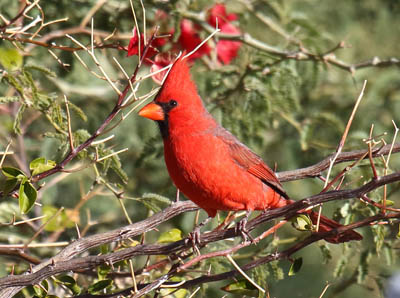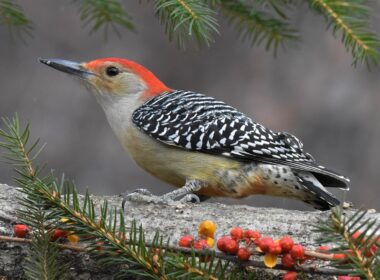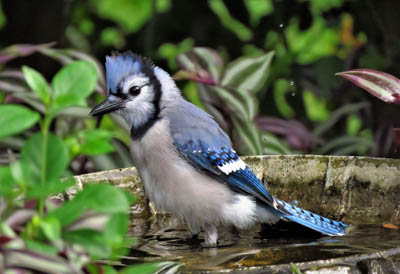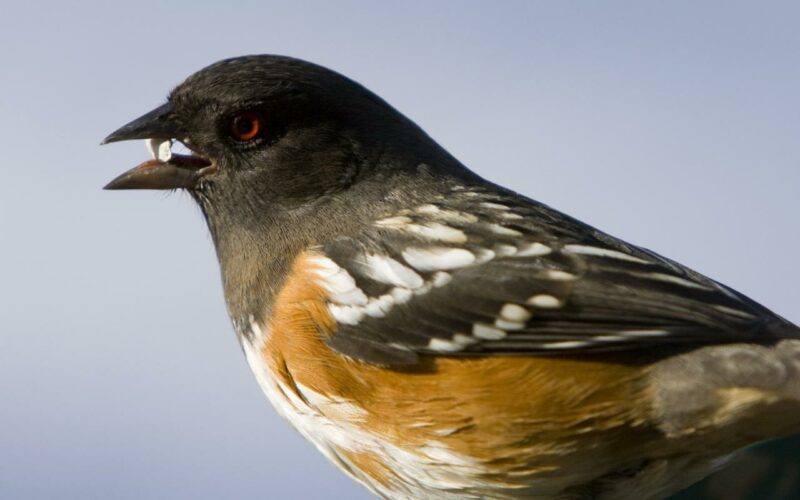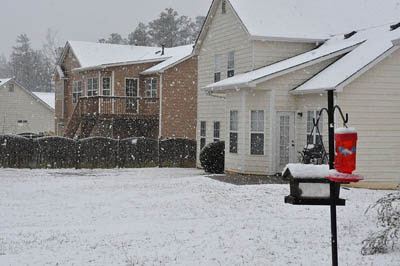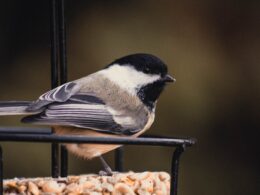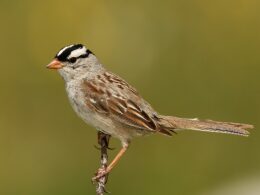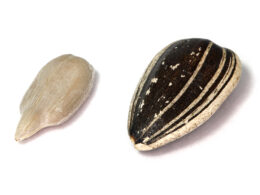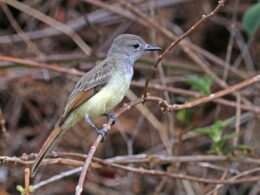Last Updated on January 21, 2024 by Greg Gillson
Winter is a wonderful time to feed birds!
Do you need ideas for what to feed the birds in your yard? Do you know what types of feeders are best for the birds you want to attract?
Would you like to see photos and brief identification of birds to expect at your feeder in winter in Oregon?
This article is for you!
This article tells why and how to set up a bird feeder in Oregon in the winter. I’ll also show you photos of the common feeder birds in Oregon that you can look for at your own backyard feeder! I will give brief identification tips. I will tell you what foods and what type of feeders attract each species.
Why feed winter birds in Oregon?
Winters are fairly mild in western Oregon. Central and Eastern Oregon are colder.
Rarely in western Oregon, there may be periods of freezing rain that can coat everything with ice for several days at a time. This is dangerous to semi-hardy birds that over-winter in that usually milder climate. During such time liquid water is the bird’s biggest needs. But high-energy food is helpful too.
Otherwise, the birds don’t usually need us to care for them. They can do just fine on their own.
Rather it is good for our own mental health to feed birds. Birds provide a link to the natural world during the often damp and dreary winter weather of the Pacific Northwest.
There are many birds common to Oregon’s backyards in winter. They provide a splash of color and entertaining activity out our window. There’s always something to see at your feeder!
Feeding birds can be a solitary activity or a social pastime. Many of your neighbors are likely also feeding birds. So it gives you common ground when saying hello or developing a deeper friendship.
What birds come to feeders in winter in Oregon?
Your winter birds are composed of both year-round residents and winter visitors.
Year-round residents, as the name suggests, stay in your yard or neighborhood all year. In summer they breed and nest and raise their young. If one of these birds come to your feeder in winter, you are likely to see them all year long.
The winter visitors to your feeder nest and raise young somewhere else. It may be as close as nearby mountain forests or as far away as Alaska. They may arrive for the “winter” in October (or earlier) and remain into April. Or you may only see them during the coldest weather. Each species timing is slightly different. But in summer they are gone.
Once you learn the common birds at your feeder, you will quickly spot something different. That’s the joy of watching birds–there’s always the chance for something new.
Learning the names of birds and keeping track of their comings and goings is an added layer to feeding birds in winter. Of course, you can feed and enjoy birds at your feeder without learning their names. But knowing who’s who makes it more enjoyable, I think.
If you are interested in the common birds in your backyard all year (not just those who come to feeders), then you should check out my article on common backyard birds of Oregon. I’ll link to this resource again at the bottom of this article.
Here, then, are the birds most likely to show up at your feeder in Oregon during winter.
Dark-eyed Junco
These tiny sparrows twitter and scold on the ground, flashing their white tail feathers.
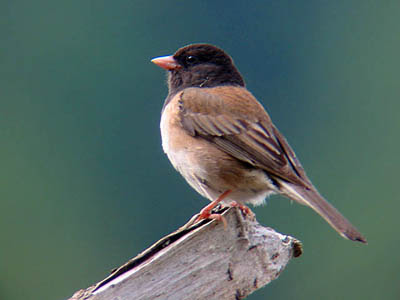 |
| Dark-eyed Junco. Greg Gillson. |
They are found in openings and the edge of conifer forests. In winter they are found in backyards from Alaska and southern Canada south through most of the United States.
Dark-eyed Juncos are year-round residents throughout Oregon.
These birds are small and horizonal on the ground with fairly long tails. The bill is small.
Most birds are brown above and white below, with pink sides. They have heads that are either black (males) or gray (females and first-year birds). Rare forms are all solid dark gray above with white belly.
Dark-eyed Juncos prefer to eat on the ground or on low platform feeders. They love millet, hulled sunflower seeds, and cracked corn.
Song Sparrow
This is a common wetland bird across North America that also hides out in backyards with large bushes and hedges.
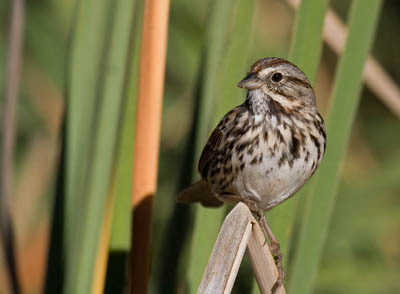 |
| Song Sparrow. Photo by Greg Gillson |
Song Sparrows are year-round residents throughout Oregon.
It forages and hops on the ground where its heavy dark brown streaking provides camouflage in the shadows.
It has a a trilled song that starts with two burry notes and a buzz. Its call sounds like chimp.
Song Sparrows will eat mixed seeds and black oil sunflower seeds from a hopper or platform feeder.
Black-capped Chickadee
This bird is a small active acrobatic ball off fluff.
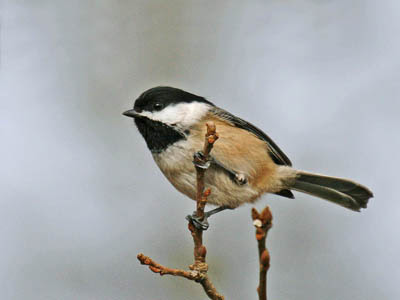 |
| Black-capped Chickadee. Greg Gillson. |
This bird is resident from Alaska and across Canada to the northern half of the United States.
Black-capped Chickadees are year-round residents in Oregon.
The white face is bordered by black crown and bib. Upper parts are gray, under parts buff.
Black-capped Chickadees love black oil sunflower seeds from hopper and tube feeders.
Northern Flicker
This big bird fools people. When they see it hopping in the lawn eating ants, they can’t imagine it is a woodpecker!
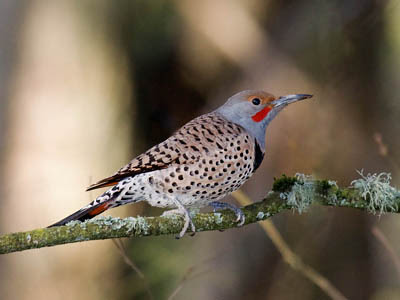 |
| Northern Flicker. Greg Gillson. |
Found in woodlands and residential trees, these birds are found in winter across the United States, except the dry southwestern deserts.
Northern Flickers are year-round residents throughout Oregon.
Large, with a big head and short pointed tail. Short legs. The bill is long but curved slightly.
Brown above, barred with black. Pinkish on under parts and heavily spotted. There is a black crescent across the chest. The face is gray and brown. White rump visible in flight. In Washington and the West, the wing linings are salmon-orange colored, very obvious in flight. In the East, the wing and tail linings are bright yellow. These, or hybrids, sometimes show up in Washington in winter.
Northern Flickers come to suet feeders and peanuts.
California Scrub-Jay
This bold, noisy, jay is common in residential backyards along the West Coast.
 |
| California Scrub-Jay. Greg Gillson |
California Scrub-Jays are year-round residents in the inland valleys of western Oregon and into central Oregon and southern Oregon.
One common call is a single hoarse rising shreeink call. A similar call is a fast repeated hoarse shrink, shrink, shrink.
It has a round blue head with an incomplete necklace of blue onto the breast. The wings and tail are also blue. The face is black. The back is gray. The under parts are white or pale gray.
Because they may gobble up a lot of sunflower seeds at once, and sometimes beat up on smaller birds, they are not welcome by everyone at the feeder.
California Scrub-Jays will eat fruit, sunflower seeds, and suet from platform or hopper feeders.
Spotted Towhee
These larger sparrows skulk under larger residential landscaping.
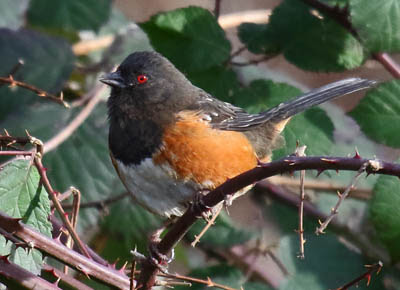 |
| Spotted Towhee. Greg Gillson. |
These birds like dense brushy habitats. In winter they are found in the West from southern British Columbia south to Texas, New Mexico, California, and mountains of Mexico.
Spotted Towhees are year-round residents in most of Oregon, absent in the treeless north-central Columbia Plateau.
These are big plump sparrows with large tails.
These birds are blackish above with white belly and rusty-orange sides. They are spotted on the wings and tail corners. They eye is strikingly red.
Spotted Towhees like sunflower and other smaller mixed seeds from the ground or low platform feeders.
Anna’s Hummingbird
One of 3 resident hummingbird species in the United States.
 |
| Anna’s Hummingbird. Greg Gillson |
Anna’s Hummingbirds are year-round residents in western and central Oregon, summer residents in south-central Oregon.
They are large and fairly noisy. They give high sharp stit notes, chatter a bit when chasing other hummingbirds. The males give a prolonged squeaky and scratchy “song” in winter and spring from an exposed perch.
They are green above and gray and green across the underparts. The male’s whole head and throat is iridescent pinkish-ruby. The female usually has a spot of pink on the central throat.
Anna’s Hummingbirds drink nectar from hummingbird feeders.
Golden-crowned Sparrow
These ground-loving birds are winter visitors to lowland hedges.
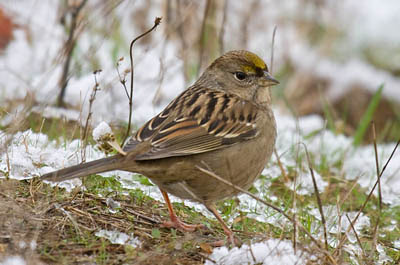 |
| Golden-crowned Sparrow. Greg Gillson. |
Found in winter on roadside edges and brushy areas, these birds winter from southwestern British Columbia to southern California.
Golden-crowned Sparrows are winter visitors to the western two-thirds of Oregon.
These are rather large and long-tailed sparrows.
These are tan birds throughout with dark brown streaked backs, very similar to white-crowned sparrows. These birds have a dark forehead with a touch of yellow on the forecrown, much brighter in breeding season.
Golden-crowned Sparrows eat sunflower and mixed seeds on the ground or low platform feeders.
House Finch
These are one of the most widespread feeder birds in the United States.
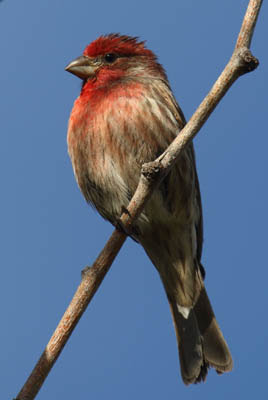 |
| House Finch. Greg Gillson. |
These birds are resident in towns throughout the United States, barely into southern Canada.
House Finches are year-round residents throughout Oregon.
Both males and females are rather dusty brown, heavily streaked on the chest. Only the males have red feathers on forehead, breast, and rump.
House Finches love to eat black oil sunflower seeds in the shell. They like tube feeders best.
Steller’s Jay
These are bold and brash birds in woodlands and backyards. But they keep a wary eye on people, despite being found in residential areas.
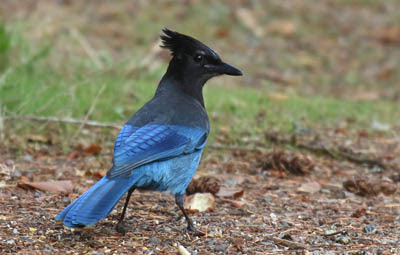 |
| Steller’s Jay. Greg Gillson. |
These birds are found primarily in conifer habitats, from seashore to mountain tops. They occur in conifer mountains of the West from southern Alaska into Mexico.
Steller’s Jays are year-round residents in western Oregon and northeastern Oregon.
These are big stocky birds with an obvious crest. They have full tails.
Their blue body, wings, and tail becomes sooty black on the back, upper breast, and entire head.
Steller’s Jays eat just about anything. They especially love peanuts and suet and will also eat sunflower seeds. They prefer larger platform feeders.
Red-breasted Nuthatch
These little birds crawl over the bark of tree limbs and trunks–even upside down!
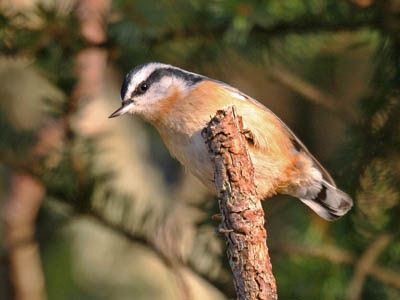 |
| Red-breasted Nuthatch. Greg Gillson. |
This species of nuthatch loves conifer trees. They are found from Alaska and across Canada. They are found in the mountains of the northern and western United States, irregularly in winter being found throughout all of the US.
Red-breasted Nuthatches are year-round residents in western and northeastern Oregon, winter visitors throughout.
These are tiny birds with a stubby tail.
Birds are bluish-gray above and delicately pinkish-orange below. The black crown and eye line set off a white eyebrow.
Red-breasted Nuthatches love black oil sunflower seeds from tube feeders. They love nuts and peanuts. They are fond of suet.
White-crowned Sparrow
These birds breed along the coast and in the high mountains.
 |
| White-crowned Sparrow. Greg Gillson |
White-crowned Sparrows are summer residents in western and northeastern Oregon and winter visitors throughout.
They are frequently found in brush piles and woody backyard shrubs.
They sing songs with sweet and cheer notes and trills in summer, but also in winter and migration. Gives a slightly metallic pink note. They have slightly different song dialects in different regions of North America.
The crown stripes of immature birds are brown and cream for the first year of life.
White-crowned Sparrows will eat black oil sunflower seeds or mixed seeds from a platform or hopper feeder.
Setting up a winter bird feeding station in Oregon
What kind of bird feeders and foods do I recommend for feeding winter birds in Oregon?
First, set up a tube feeder with black oil sunflower seeds for chickadees, nuthatches, finches. This type of feeder deters hungry and more aggressive jays and House Sparrows.
Next, set up a hopper feeder with mixed seeds for juncos, sparrows, towhees, and jays. This is a generic feeder and food that attracts most seed-eating birds.
Finally, set up a suet feeder for flicker, woodpeckers, chickadees, nuthatches, and several species that don’t regularly eat seeds. To keep out jays and blackbirds use upside-down suet feeder.
Wrapping Up
The diverse geography of Oregon plays a significant role in shaping the bird species that winter there. Here’s how:
Climatic Variations:
- West Coast vs. Eastern Oregon: The coastal ranges create a rain shadow effect, with the west side receiving much more precipitation than the east. This translates to lush forests and more varied food sources on the west, while the dry, high desert landscapes of the east attract different wintering birds adapted to arid conditions.
- Mountain Ranges: The Cascade Mountains and Blue Mountains further impact temperature and precipitation patterns, creating colder, snowier habitats at higher elevations that attract different birds than the valleys below.
Habitat Diversity:
- Coastal Habitats: Rocky shores, estuaries, and coastal forests offer refuge and food for seabirds, shorebirds, and forest birds that wouldn’t be found in the interior.
- Willamette Valley and Southern Oregon: The fertile lowlands and oak woodlands provide wintering grounds for songbirds, waterfowl, and raptors.
- High Deserts: Juniper woodlands, sagebrush steppes, and playas (shallow lakes) support specialized birds like sage thrashers, Brewer’s sparrows, and northern harriers.
Food Availability:
- Western Forests: Abundant berries, seeds, and insects in coniferous and deciduous forests attract frugivorous and insectivorous birds.
- Coastal Waters: Marine resources like fish, mollusks, and crustaceans attract seabirds and diving ducks.
- Open Fields and Deserts: Seeds, berries, and small mammals in these drier regions cater to sparrows, juncos, and raptors.
Migration Patterns:
- North-South Movement: Many birds that breed in northern forests migrate south to Oregon for the winter, seeking milder temperatures and more abundant food.
- Elevation Shifts: Some birds move down from higher mountain slopes to lower valleys in winter, where temperatures are milder and food is more accessible.
Examples:
- Western Tanagers: Winter in the oak woodlands of western Oregon, feeding on berries and insects.
- Snow Geese: Migrate from the Arctic to the Willamette Valley and southern Oregon, where they graze on fields and marshes.
- Common Loons: Winter along the Oregon coast, diving for fish in the cold Pacific waters.
- Sage Thrashers: Year-round residents of the high desert, adapted to the dry conditions and feeding on insects and berries.
Frequently Asked Questions
What birds migrate south from Oregon?
Many fascinating birds migrate south from Oregon for the winter, seeking warmer temperatures and abundant food sources. Here are some prominent examples:
Warblers:
- Yellow Warblers: These bright yellow songbirds head south to Central and South America.
- American Redstarts: Their flashy black and orange plumage graces southern Florida and beyond in winter.
- Ovenbirds: Travel to the Greater Antilles and northern South America.
- Black-throated Blue Warblers: Migrate to the Caribbean and northern South America.
- Hooded Warblers: Seek warmer climes in Central America and northern South America.
Tanagers:
- Scarlet Tanagers: These vibrant red birds spend winter in northern South America.
- Summer Tanagers: Migrate to Central and South America.
Other Songbirds:
- Orioles (Baltimore Orioles, Orchard Orioles): Head south to Mexico, Central America, and northern South America.
- Yellow-billed Cuckoos: Travel to South America for the winter.
- Hummingbirds (Ruby-throated Hummingbirds): Some individuals venture to southern Florida or Mexico, while others stay year-round in milder parts of Oregon.
- Vireos (White-eyed Vireos, Yellow-throated Vireos): Migrate to the Bahamas, Cuba, and Central America.
- Flycatchers (Great Crested Flycatchers, Eastern Wood-Pewees): Seek warmth in Mexico, Central America, and northern South America.
What birds enjoy the cold winter in Oregon?
While some birds migrate south from Oregon’s winter chill, many others embrace the colder months and thrive in the unique landscape. Here are some birds that enjoy the chilly season in Oregon:
Snow-Loving Specialists:
- Snow Buntings: These hardy beauties with black and white plumage flock to snowy fields and mountains, feasting on seeds and berries exposed by the frozen ground.
- White-winged Crossbills: Their specialized beaks perfectly crack open frozen pine cones, making them masters of winter foraging in coniferous forests.
- Common Redpolls: These small finches find plenty of food in weed seeds and frozen berries, adding splashes of pink to the snowy landscape with their rosy chests.
- Clark’s Nutcrackers: These intelligent birds cache food throughout the year, relying on their hidden stashes during the winter months.
Related Articles:



